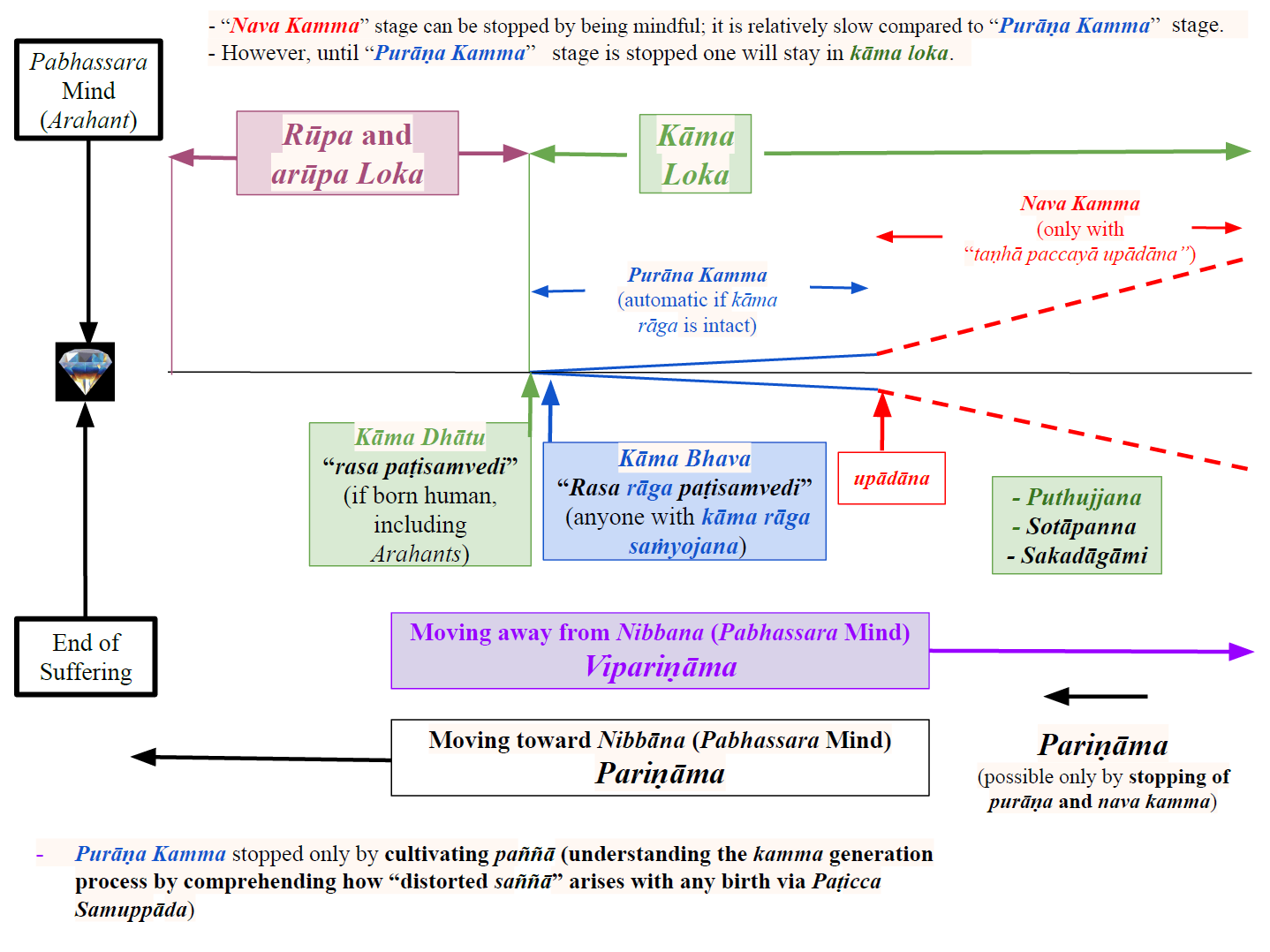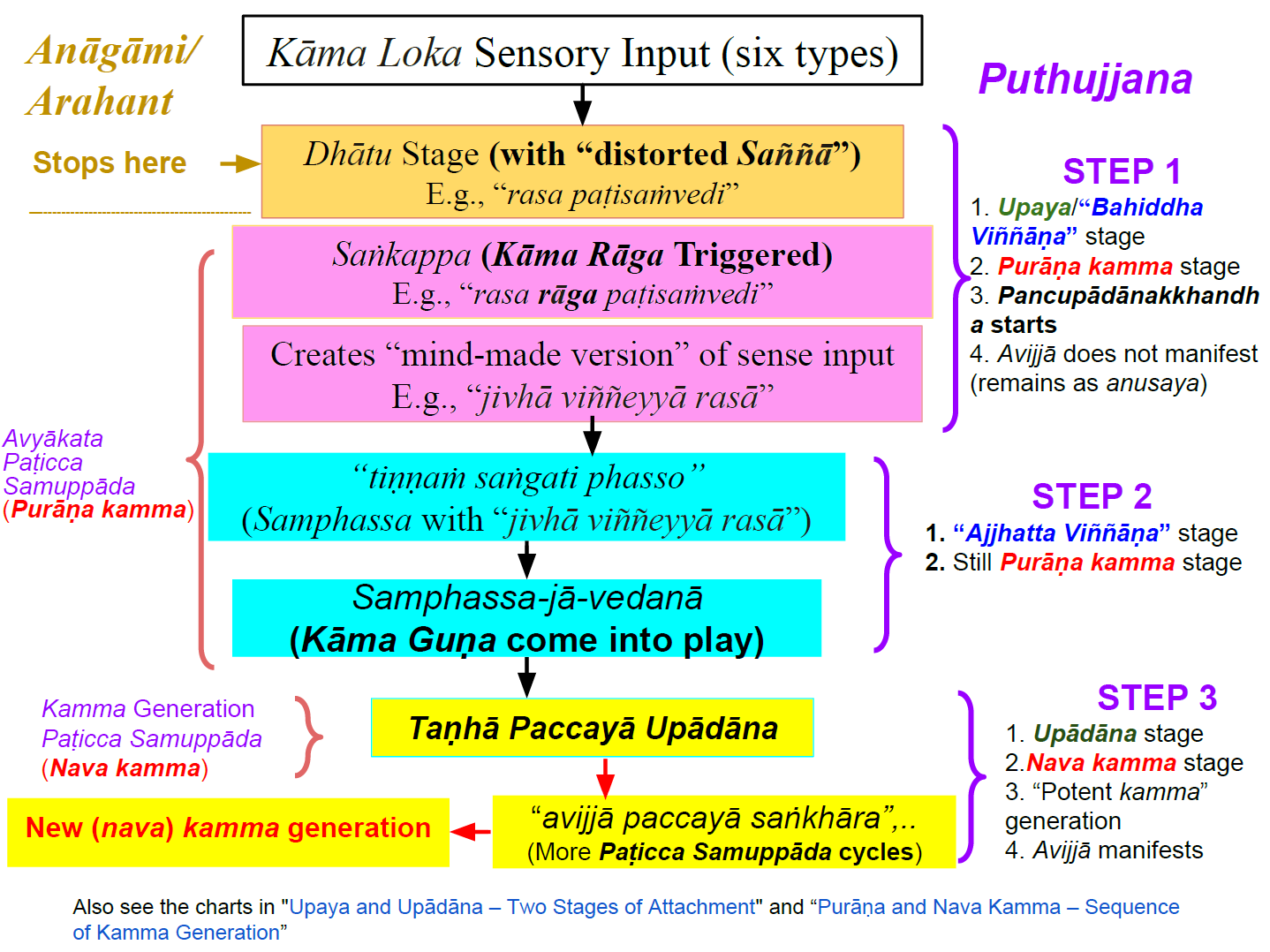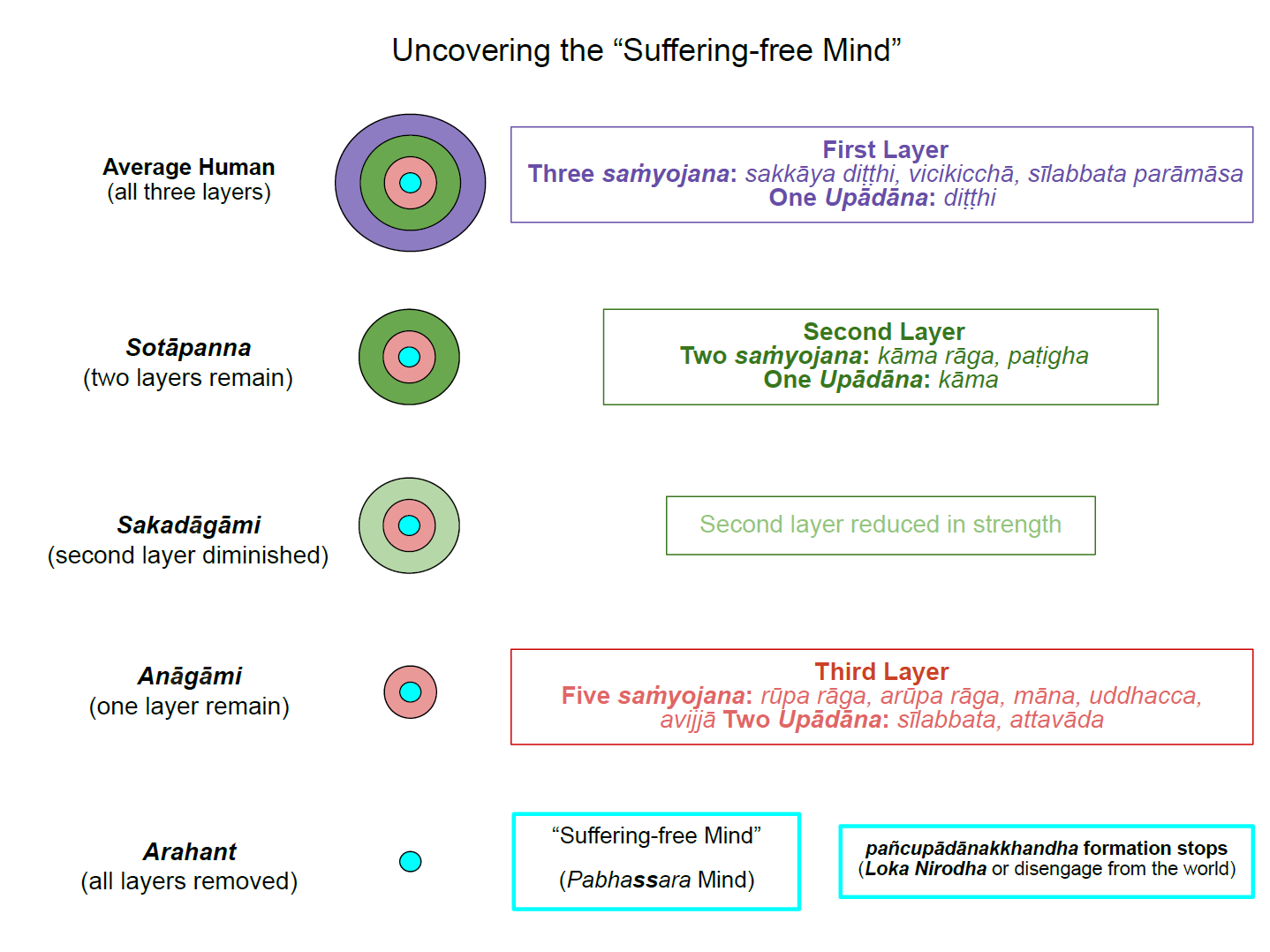March 12, 2024
Ārammaṇa means a sensory input. It initiates kamma generation via Paṭicca Samuppāda and adds to pañcupādānakkhandha (“five grasping aggregates.”) No one below the Arahant stage generates pañcakkhandha (“five aggregates.”)
Anicca, Dukkha, Anatta for a Puthujjana
1. Any average human (puthujjana) has the wrong view (diṭṭhi) and innate wrong perception (saññā) that things in the external world have mind-pleasing characteristics of nicca, sukha, and atta. Those are called “diṭṭhi vipallāsa” and “saññā vipallāsa” respectively. For example, “If I can marry that person or buy that big house or buy that expensive car, I will have a happy life.”
▪What are anicca, dukkha, and anatta for a puthujjana? It is not being able to obtain those material things.
▪When one succeeds in achieving such goals, they become elated. Enjoying such possessions is called “kāma assāda.”
▪However, all those things lose appeal with time: people get old and die, and things get old and can be destroyed or damaged. Those outcomes are inevitable. That is “ādīnava” or “drawbacks of enjoying “kāma assāda.”
2. Many people do not take into account another aspect: the “dangerous consequences” of engaging in immoral deeds (akusala kamma) while seeking such “kāma assāda.”
▪Akusala kamma leads to harmful consequences (vipāka), including rebirth as animals or worse. Many people do not pay attention to this because most vipāka materialize later in life or even in future births.
▪The net effect of both these aspects is suffering in the long run.
3. Most people are unaware of one or both aspects in #1 and #2: According to the Buddha, seeking happiness via material gains ALWAYS leads to suffering in the long run.
▪However, “trying to get hold of mind-pleasing things” is the only option for a puthujjana because they are unaware of Buddha’s teachings.
▪They don’t KNOW that there is a guaranteed way to eliminate all suffering by eliminating diṭṭhi and saññā vipallāsa.
Why Do We Seek Pleasure in Worldly Things?
4. A puthujjana seeks to possess “material wealth” because they perceive such things can bring us happiness. Two critical factors contribute to that.
(i.)“Bad consequences” of pursuing “mind-pleasing things” (kamma vipāka) may not be seen for a long time, sometimes over many rebirths into the future.
(ii.)The perception (saññā) that certain things in the world can bring us happiness is an illusion (“distorted saññā”) “built into our minds.”
▪One can become a Sotāpanna by understanding (i) above and removing diṭṭhi vipallāsa. However, to practice Satipaṭṭhāna and reach the Sakadāgāmi/Anāgāmi stages, one MUST understand (ii) as well, via removal of saññā vipallāsa.
▪Furthermore, understanding (i) and (ii) will make it easier to reach the Sotāpanna stage.
▪See “Vipallāsa (Diṭṭhi, Saññā, Citta) Affect Saṅkhāra.”
Buddha Dhamma – Two (Related) Paradigm Changes
5. Everything (living beings and material things) arises and perishes based on a universal principle, Paṭicca Samuppāda. The logical process can be stated as follows.
(i.)The perception (saññā) that certain things in the world can bring us happiness is an illusion; however, a puthujjana does not know that. Based on that wrong perception (“distorted saññā”), people engage in immoral deeds to acquire such things.
(ii.)Such immoral deeds (akusala kamma) are done with a defiled mind contaminated with greed/attachment (rāga) and anger/hate (dosa), and those two arise based on ignorance (moha/avijjā). Such akusala kamma can bring their results (kamma vipāka) at any time in the future, during this life or in future lives.
▪The above two aspects are interconnected. Kamma vipāka not only brings good/bad outcomes but also leads to rebirths with “built-in distorted saññā.” One universal principle explains both factors: The world operates on a “bad foundation,” i.e., Paṭicca Samuppāda.
▪Stopping the Paṭicca Samuppāda process can stop both effects and, thus, future suffering.
▪We discussed the “distorted saññā” only within the past several months. The timeline is in “Sotāpanna Stage via Understanding Perception (Saññā).”
6. Thus, the two main concepts to be learned are:
(i.)A puthujjana attaches to external objects, thinking they have intrinsic “kāma guṇa” that can provide “pleasure.” Thus, they have “high hopes” and desire to acquire more such things, and that expectation is “viññāṇa.” But the Buddha taught that such an expectation is like chasing a mirage because external objects do not have such “mind-pleasing” intrinsic properties.
(ii.)However, the “distorted saññā” (that is “built-in” to each existence) makes it appear that such external things can provide happiness. Understanding the concept of “saññā” is essential to understand this issue. Perception is the closest English word for “saññā.” The “distorted saññā” is much more than a view; it is built into our psyche and also built into our physical bodies so that bodily functions seem to be compatible. That is why it is hard to overcome this “distorted saññā.”
▪Paṭicca Samuppāda explains both aspects (how our bodies arise with built-in “distorted saññā” AND how our immoral actions based on that “distorted saññā” lead to future suffering).
Most Akusala Kamma Are Done in Kāma Loka
7. In the previous two posts, “Rūpa and Rūpakkhandha- Not External Objects” and “Vipariṇāma – Two Meanings,” we discussed that most akusala kamma are done while in kāma loka. Thus, an Anāgāmi (who has overcome rebirths in kāma loka) is free of most of the suffering in this world.
▪The following chart is an update to the one discussed in those posts. It focuses on the kamma generation in kāma loka. The kamma generation happens in two steps: “purāṇa kamma” and “nava kamma.”

Nibbāna and the Kāma Loka
Download/Print: “WebLink: PDF file Download: Nibbāna and the Kāma Loka”
Sensory input (Ārammaṇa) Activates the Mind
8. Sensory input (ārammaṇa) must trigger the mind to the “active state.” See “Future Suffering (Loka/Dukkha Samudaya) Starts With Sensory Input (Ārammaṇa).” The mind of a human in kāma loka starts at the “kāma dhātu” stage.
▪In the above chart, a “taste input” illustrates an example. At the initial “kāma dhātu” stage, the “distorted saññā” corresponding to that sensory input arises automatically, i.e., it is the “rasa paṭisaṁvedī” step for a “taste input.” Anyone born a human (including an Arahant) will taste, for example, the “sweetness of sugar.”
▪However, Arahant’s mind (or even the mind of an Anāgāmi) will not reach the next stage of the “rasa rāga paṭisaṁvedī” step. That is because they have eliminated “kāma rāga saṁyojana.” Note that saṁyojana can be interpreted as “saŋ” + “yoga” (bonding with defilements) or “saññā” + “yoga” (bonding with “distorted saññā”); they both lead to the same result. The word in the original Pāli is “සඤ්ඤොජන,” which should be written as “saññojana.” For example, the original version of “WebLink: suttacentral: Saṁyojaniya Sutta (SN 35.109)” is “WebLink: Image file Download: Saṁyojana Sutta (SN 35.109) in Pāli (Sinhala script).”
9. But the mind of anyone below the Anāgāmi stage will automatically attach to that “distorted saññā” of sweetness and get into “kāma bhava.”
▪However, from there, it is not guaranteed that the mind will go through the “taṇhā paccayā upādāna” step and get into the “rapid growth of viññāṇa” in the “nava kamma” stage. That depends on the mindset at that particular moment. For example, if one is watching an erotic movie, the sight of an attractive person in the movie may induce lust; however, the sight of a similar woman while contemplating a Dhamma concept may not trigger that arousal.
▪The main point is the following: Anyone below the Anāgāmi stage will automatically get into the “purāṇa kamma” stage; that depends only on whether one has the “kāma rāga saṁyojana” intact. However, getting into the “taṇhā paccayā upādāna” step and accumulating “new kamma” in the “nava kamma” stage is NOT automatic; that is why broken lines indicate it in the above chart.
Sensory input (Ārammaṇa) Initiates Paṭicca Samuppāda Process
10. The same concepts are presented differently in the chart below. Make sure to read the text in #8 while studying the chart. Also, read #9 and #10 of “Saññā – All Our Thoughts Arise With ‘Distorted Saññā’” and “Kāma Guṇa – Origin of Attachment (Taṇhā)” where the “WebLink: suttacentral: Upavāṇasandiṭṭhika Sutta (SN 35.70)” is discussed using a visual sensory input (compared to the taste input here.) It is critical to understand these points.

Sequence of Kamma Generation - Kāma Loka
Download/Print: “WebLink: PDF file Download: Sequence of Kamma Generation – Kāma Loka“
Sensory input (Ārammaṇa) Initiates Pañca Upādāna Khandha
11. The main point in the above chart is that the mind of a puthujjana (or even a Sotāpanna/Sakadāgāmi) starts in a “defiled state.” Specifically, it does not start at the pañcakkhandha state but at the pañca upādānakkhandha state (in the above charts at the “rasa rāga paṭisaṁvedī” step.)
▪We know that a mind becomes active with a sensory event; see “Loka Sutta—Origin and Cessation of the World.”
▪In #1 of that post, we discussed the “WebLink: suttacentral: Loka Sutta (SN 12.44)” with an example of a visual sensory event, i.e., seeing an object. The first step is “cakkhuñca paṭicca rūpe ca uppajjati cakkhu viññāṇaṁ.” In the above chart, the same step occurs for a “taste input” coming in (@marker 3.3 of the sutta): “jivhañca paṭicca rase ca uppajjati jivhā viññāṇaṁ.” That step is described by the first four boxes in the above chart. Yes. All steps up to the “Tiṇṇaṁ saṅgati phasso” box in green happen within “jivhañca paṭicca rase ca uppajjati jivhā viññāṇaṁ.”
▪The subsequent two steps in the above chart are the same as those in the “Loka Sutta (SN 12.44),” i.e., “tiṇṇaṁ saṅgati phasso” and “phassa paccayā vedanā.” Note that “phassa paccayā vedanā” means “samphassa-jā-vedanā.”
▪All those steps occur in a split second during the “purāṇa kamma” stage. That is the same as “Avyākata Paṭicca Samuppāda,” where “avyākata” means “no strong kammic energy created.” However, since kāma rāga has arisen with “rasa rāga paṭisaṁvedī” (see the first chart), the mind has transcended the “kāma dhātu” stage and has entered “kāma bhava.” That does not occur for an Anāgāmi or Arahant.
“Nava Kamma” Stage Only With “Upādāna”
12. Next is the critical “taṇhā paccayā upādāna” step. This step may or may not occur even for a puthujjana if the mind is not interested in the sensory input. As we know, “taṇhā” means to “bind” or “attach.” Depending on the strength of the sense input AND the mindset at that moment, the mind may or may not get to the “taṇhā paccayā upādāna” step.
▪If the mind does, it is interested in pursuing that sensory input. It has attached itself to the sense input and wants “more of it.” That is what is meant by “upādāna,” i.e., to “pull it close.” That happens because of the wrong perception that sight, sound, and body touch have certain intrinsic “kāma guṇa.” That wrong perception motivates one to try to get “more of it.”
▪That is when one starts generating mano, vacī, kāya saṅkhāra (strong kamma) with “avijjā paccayā saṅkhāra” in the “nava kamma” stage, where kamma accumulation with javana citta occur consciously (and, thus, can be stopped by being mindful.) That is the beginning of the “kamma generation Paṭicca Samuppāda” or “Akusala-Mūla Paṭicca Samuppāda.” That proceeds all the way to “jāti paccayā jarā, maraṇa, soka-parideva-dukkha-domanassupāyasā sambhavan’ti.” That is how the process ends with suffering or “generating kammic energy to bring future suffering.”
▪Thus, the above process describes the complete “Idappaccayātā Paṭicca Samuppāda” process, which includes “Avyākata Paṭicca Samuppāda” and “Akusala-Mūla Paṭicca Samuppāda.” Details are in “Paṭicca Samuppāda During a Lifetime.” Please make sure to review that to grasp these fundamental concepts.
Recovering the Pabhassara (Pure) Mind
13. The first chart (in #7) above shows that kāma loka is the furthest from the “suffering-free pure (pabhassara) mind.”
▪The chart below explains why the kāma loka is the furthest from the “suffering-free pure (pabhassara) mind.”

Defilements Covering a Pure Mind
Download/Print: “WebLink: PDF file Download: Defilements Covering a Pure Mind”
Removal of Defilements Only With Wisdom (Paññā)
14. There are three layers of “hardened defilements” that keep a “suffering-free pure (pabhassara) mind” covered at all times. The Buddha described those “hardened defilements” in various ways: The outermost layer can be labeled as three saṁyojana, one upādāna, two anusaya, one āsava, etc.; see “Conditions for the Four Stages of Nibbāna” for parameters for all three layers. For simplicity, I have indicated only the saṁyojana and upādāna in the above chart.
▪The first layer is removed permanently when one gets to the Sotāpanna stage. This stage can be reached without understanding the “distorted saññā.” It is enough to understand that material things do not have “kāma guṇa” and that engaging in akusala kamma to get hold of “material things (people and inert objects) will only lead to future suffering.
▪The other two layers are removed at the Anāgāmi and Arahant stages via cultivating Satipaṭṭhāna.
15. It is also critical to understand that removing all “three layers” covering a pabhassara mind is possible only by cultivating wisdom (paññā).
▪It is not like removing a “physical mud layer.” This is entirely a mental process. In the case of Ven. Bāhiya, all three layers disappeared within a few minutes; see “WebLink: suttacentral: Bāhiya Sutta (KN Ud 1.10).” Many others struggle for years to get to the Sotāpanna stage by removing the first layer.
▪One does not need to worry about how to remove any of those layers one by one. As one understands how a mind gets defiled (i.e., cultivate paññā), they will disappear automatically.
Connection to “Distorted Saññā”
16. One must understand why it is harmful to chase sensory pleasures. To reach the Sotāpanna stage, one does not need to give up all sensory pleasures; one only needs to “see with wisdom” that attachment to sensory pleasures keeps one away from Nibbāna. That understanding will remove the first layer of defilements in the above chart. After that, the mind will be incapable of committing “apāyagāmi kamma.” There is no need to stop such actions consciously.
▪However, a Sotāpanna has not removed the tendency to attach to the “distorted saññā.” Even though the diṭṭhi vipallāsa about kāma assāda is removed, the saññā vipallāsa to attach to the “distorted saññā” is still there (saññā vipallāsa means to be “fooled by the “distorted saññā.”)
▪Overcoming that saññā vipallāsa requires the practice of Satipaṭṭhāna, which in turn requires understanding how “distorted saññā” arises via Paṭicca Samuppāda. The removal of saññā vipallāsa leads to the disappearance of “kāma rāga saṁyojana” and “kāma upādāna.”
▪The critical point is that rebirths (with inherent, built-in “distorted saññā”) occur according to the types of saṅkhāra cultivated with certain types of gati, and the resulting rebirths propagate the same gati. That is a self-feeding, never-ending process! That loop must be broken to escape the “kāma loka” and to start progressing toward Nibbāna or the “Pabhassara mind” (see the first chart.) See #2 of “Mūlapariyāya Sutta – The Root of All Things.”
Summary
17. We discussed many critical concepts and their relationships above. Understanding this “big picture” is essential.
▪For an average human (who has not comprehended Buddha Dhamma), suffering means “not being able to enjoy sensory pleasures.” However, once understanding (jānato passato) Buddha’s core teachings, one can see that “enjoying sensory pleasures” is the root cause of suffering. That is the “previously unheard teachings of a Buddha.”
▪The easiest way to see that is in the first chart. Any time one attaches to a sensory input, only two possibilities are there for a puthujjana: (i) one will either stay at the same place or (ii)) start moving away from the “suffering-free pabhassara mind.”
▪Whether a puthujjana experiences joy, depression/pain, or neutrality about a given sensory input, he/she will not be moving toward the “suffering-free pabhassara mind.” Think about that deeply. This is why escaping the sansāric journey (rebirth process) is impossible without learning Buddha’s teachings. Feel free to ask questions at the forum.
18. If sensory input (ārammaṇa) leads to both purāṇa and nava kamma stages, all three following happens:
(i.)It is a complete Paṭicca Samuppāda process (with “Avyākata Paṭicca Samuppāda” and “Akusala-Mūla Paṭicca Samuppāda.”)
(ii.)It is another addition to pañca upādāna khandha (and this also explains why pañcakkhandha or five aggregates never arise for anyone below the Arahant stage.)
(iii.)Chasing a sensory input keeps one bound to the world. The Buddha equated this to the “rising/origin of the world.” See “Loka Sutta – Origin and Cessation of the World.” The moment one attains Arahanthood, that “rising/origin of the world” stops (Paṭicca Samuppāda process stops), and that is the “ending of the world” or “loka nirodha.” That Arahant is no longer “in this world.”